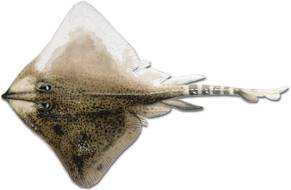 |
 |
 |
 |
 |
 |
 |
 |
 |
 |
 |
 |
 |
 |
 |
 |
 |
 |
 |
 |
 |
 |
 |
 |
 |
 |
 |
 |
 |
 |
 |
 |
 |
 |
 |
 |
|
|
 |
|
|
|
 |
|
|
|
Thornback Ray |
|
 |
|
|
|
|
|
|
 |
|
|
|
|
|
|
|
Distribution: |
|
Common around the Irish coast with hot spots being Cork, Kerry, Wicklow, Cahore and Courtown in Co. Wexford and parts of the West coast. |
|
|
|
|
|
|
|
|
|
|
|
Habitat: |
|
|
|
|
|
Thornbacks like all Ray like clean sandy ground and mud. Obvious spots are on the downtide side of sand banks. Water depths range from 50ft- over 100ft but they can sometimes be caught in shallower water. They like to sit in crevices and evade the tide run waiting to pounce on passing fish. In certain areas they will move into estuary mouths to feed on the abundant shellfish and crab. |
|
|
|
|
|
|
|
|
|
|
|
Thornbacks are generally caught from May to October but can stay longer if the weather is warm. |
|
|
|
|
Season: |
|
|
|
|
|
|
|
|
|
|
|
|
Tides and Weather: |
|
|
|
|
|
The big spring tides are the best. Coming up on the first two hours of the tide and over slack water. Rays tend to bed down during a strong tide run. Easterly winds are not good for Ray. |
|
|
|
|
|
|
|
|
|
|
|
Bait: |
|
Thornies are beleived to use their powerful jaws for crushing their prey which suggests that shellfish and custacions such as squat lobster and crabs would range in their diet. However, Fish baits are usually the most successful. Baits such as Sandeel and tail cuts of Mackeral, small Dabs and Herring work well. Crab can also account for Rays as does Squid but most anglers tend to go for fish baits. A head and gut of Mackeral works well as it is scent that catches Ray. They have relatively bad eye sight and are closely related to the Shark species which are attracted to strong scents. A well prepared bag of rubby dubby often works wonders. |
|
|
|
|
|
|
|
|
|
|
|
Tactics: |
|
|
|
|
|
Rays like to stick out of the main tide run. Look for areas at the edge of reefs and sand banks where the rays can hide. Use a sliding ledger rig with a trace of about four foot. The most important thing to remember about Ray is to leave the drag set as a boat rod left alone can be pulled over the side. Ray fishing is a waiting game just like Tope fishing with Doggie often putting an apearence. You can get away with bigger hooks from 4/0 - 5/0 and these will reduce your number of dogs. Let bites develop. Often you will not even know you have a ray until you reel in for a bait check but more often they begin with a series of taps which is the Ray moving in on the bait. The Ray usually lands on the bait to prevent it from escaping much like an octopuss does and will then stay there as he moves around and works it into his mouth. Sometimes they will then try to move off and this is when you set the hook. This is why you need the drag set. |
|
|
|
|
|
|
|
|
|
|
|
 |
|
|
|
|
|
|
|
Thornback Ray Profile |
|
|
|
|
|
|
|
Back to Home Page |
|
|
|
|
|
Back to Species List |
|
|
|
|
|
|
|
|
|
 |
|
|
|



